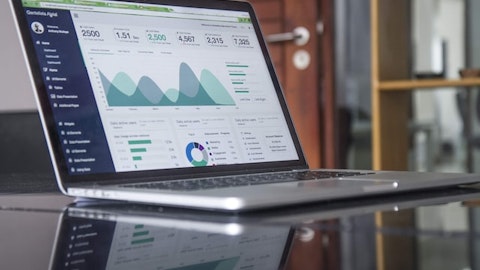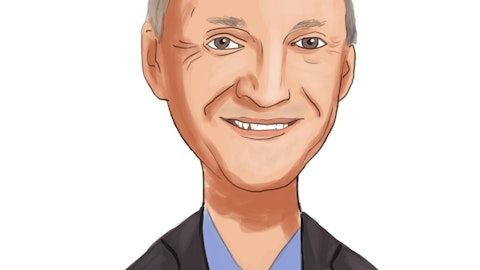OFG Bancorp (NYSE:OFG) Q3 2023 Earnings Call Transcript October 20, 2023
OFG Bancorp beats earnings expectations. Reported EPS is $0.95, expectations were $0.92.
Operator: Good morning. Thank you for joining OFG Bancorp’s Conference Call. My name is James, I will be your operator today. Our speakers are Jose Rafael Fernandez, Chief Executive Officer and Vice Chair of the Board of Directors; and Maritza Arizmendi, Chief Financial Officer. A presentation accompanies today’s remarks. It can be found on the home page of the OFG website under the Third Quarter 2023 section. This call may feature certain forward-looking statements about management’s goals, plans and expectations. These statements are subject to risks and uncertainties outlined in the Risk Factors section of OFG’s SEC filings. Actual results may differ materially from those currently anticipated. We disclaim any obligation to update information disclosed in this call as a result of developments that occur afterwards. [Operator Instructions]. I’d now like to turn the call over to Mr. Fernandez.
Jose Rafael Fernandez : Good morning, and thank you for joining us. We are very pleased to report our third quarter results. All our businesses performed well, and we continue to generate steady year-over-year revenue and earnings growth. Highlights include increased loan balances, stable core deposits with low cumulative beta, increased operating leverage and strong credit and performance metrics. Our digital-first strategy continues to attract customers and speed the transition of routine transactions from in-branch to digital platforms. This makes it easier for customers to do their banking and for us to increase efficiency and engage in more business development activities. In Puerto Rico, consumer liquidity is sound and the economy is doing well.
As always, thanks to our team for helping our customers and the communities we serve achieve their financial goals. Please turn to Page 3 for a summary of our third quarter results. First, looking at the income statement. Earnings per share diluted was $0.95, an increase of 9% year-over-year. Total core revenues were $172.2 million, up 10% compared to last year. Net interest margin was 5.8%, provision was $16.4 million and noninterest expenses were $90.2 million. Pre-provision net revenues totaled $82.3 million, up 18% year-over-year. Now turning to the balance sheet. Total assets increased to $10.3 billion from last quarter. Based on our growth and outlook for next year, we will remain above $10 billion. Customer deposits were stable at approximately $8.5 billion.
Loans held for investment totaled $7.3 billion, up 2% from the second quarter. New loan production was approximately $563 million, in line with the last 5 quarters. Investments increased to $2.1 billion and cash declined to $533 million. Moving to capital. The CET1 ratio was 14.03%, level with the second quarter. We bought back about 74,000 OFG shares in the third quarter. Please turn to Page 4 for an update on our digital first strategy. Looking at data year-to-date September compared to the same period a year ago, 87% of all routine retail customer transactions and 92% of all retail deposit transactions are now being made through digital and self-service channels. This has been driven by 11% growth in digital enrollment, 14% growth in digital loan payments, 5% growth in kiosk usage and the success of our recently deployed Oriental Servicing portal.
The portal is a cornerstone of our self-service strategy. Customers can manage all loan and deposit accounts in one place. The portal now enables digital account opening for checking, savings and CDs, applying for and accessing loans, managing automatic loan payments, and downloading a wide variety of bank letters and tax documents that customers in Puerto Rico frequently request in our branches or by phone. New features to the portal will continue to be added on a regular basis. All this continues to validate our strategy and investments in technology. As I have mentioned before, they help us provide more value-added service, increase our efficiency and assign more staff for new business development activities. Having said that, branches continue to be an important component of our island-wide sales and service network.
During the third quarter, we opened a new branch in Dorado, an area with good commercial and retail opportunities. As you probably already know, Dorado is a growing high net-worth suburb of San Juan that has attracted many new residents from the Mainland. We already have a 9% market share there, and we think we can grow further. These developments, both digital and physical, continue to better position us to serve our customers and communities and grow our businesses. Now here is Maritza to go over the financials in more detail.
Maritza Arizmendi : Thank you, Jose. Please turn to Page 5 to review our financial highlights. Let me start with total core revenues. Net interest income totaled $142 million, an increase of 1.5% from the second quarter. This reflected the full effect of the fed 25 basis points increase in the second quarter, the partial effect of the 25 basis point increase in the third quarter. Higher yield on higher loan balances, in particular variable rates and new loans, higher balances and yield on investment securities and one extra day, which added around $1 million. Banking and wealth management revenues were $30.4 million, approximately level with the second and year ago quarters. Other noninterest income totaled about $300,000. This compared to a loss of about $800,000 in the second quarter due to the early sales of our $200 million treasury loans.
The efficiency ratio was 52.36%, reflected continuous growth, strong operating leverage. Noninterest expense totaled $90 million, $1 million higher than the second quarter. This reflected lower gains on the sale of closed real estate, partially offset by lower G&A expenses. We expect noninterest expenses to continue to average about $90 million to $92 million next quarter and next year. The efficiency ratio will continue in the low to mid-50% range. Other performance metrics remained high. Return on average asset was 1.76%. Return on average tangible common equity was 17.59% and tangible book value per share was $21.01. Please turn to Page 5 to review our operational highlights. Average loan balances increased $188 million from the second quarter.

Copyright: prykhodov / 123RF Stock Photo
The end-of-period balance increased $144 million. Growth continued to reflect increases in Puerto Rico and U.S. commercial loans and retail auto and consumer loans. This was partially offset by the continued regular paydowns on the residential mortgages. Loan yield was 7.84%, up 8 basis points from the second quarter. This reflected increases from variable rate commercial loans and higher yields on new auto, consumer and commercial loans. Average core deposits increased $90 million for the second quarter, while the end-of-period balance was approximately level with June 30. Retail deposits declined $102 million, commercial increased $73 million and government increased $30 million. We continue to see a shift to time deposit and wealth management.
Core deposit cost was 90 basis points compared to 69 in the second quarter. This increase of 21 basis points mainly relates to 6 basis points due to higher rates on government deposits, 6 basis points in time deposits, 4 basis points in commercial now and savings accounts and 4 basis points in retail now and savings accounts. As of the third quarter, our cumulative deposit beta has been 19%. Excluding government deposit, it was 14%. Through this cycle, we continue to expect a cumulative deposit beta of about 25% at the end of this year. Average borrowings were $264 million, while the end of period balance was $452 million. The increase reflected our asset liability management strategies during the quarter. Net interest margin was 5.80%. That compares to $5.90 in the second quarter.
Our effective tax rate was 32%, which should be our rate for the next — for the year. Please turn to Page 7 to review our credit quality and capital strength. Net charge-offs totaled $18.8 million. That compares to $6.6 million in the second quarter. The third quarter included about $7 million for 2 U.S. loans previously and substantially reserved. This compares to the second quarter, which included a $4 million recovery from the sale of older fully charged-off auto and consumer loans. Provision for credit losses totaled $16.4 million. This included more than $11 million due to increased loan volume, $4 million in quantitative adjustment mainly related to the auto loan portfolio and $700,000 for a specific for the sale of a small portfolio of nonperforming Puerto Rico small business commercial loans.
Overall, credit continues to be strong. Early and total delinquency rates were 2.75% and 30.78, respectively. The nonperforming loan rate at 1.33% was in the lower ranges seen over the last 5 quarters. Looking at some of our other capital metrics, total stockholders’ equity was $1.1 billion, and the TCE ratio was 9.4%. To sum up, during the third quarter, we saw a steady revenue growth from higher yields on higher loan and security balances, good originations driven by auto, commercial and consumer lending. Deposit costs increased from higher average balances during the quarter and higher rates, but betas remained well below peers. End of the year balances were approximate level with the second quarter, credit conditions remained benign, net charge-offs were higher due to U.S. commercial loans and expenses were in line with our expected range.
Now here is Jose.
Jose Rafael Fernandez : Thank you, Maritza. Please turn to Page 8. Our outlook has not changed from the second quarter call. The economy continues to do well, supported by the flow of federal funds to rebuild the island infrastructure as well as additional federal funding from the inflation reduction on the CHIPS Act. With this as a backdrop, consumers continue to deploy their liquidity, and U.S. private capital and local businesses are investing to acquire, expand and grow their operations on the island. Having said that, we continue to keep our eye on the potential impact of interest rate changes, inflation and a possible mainland recession. Also, and while it’s unlikely to affect Puerto Rico directly, the recent incursions in Israel and the mounting events in the Middle East region leave us with a heavy heart, and our wishes for an early end to the fighting and for pace.
We can help but be concerned about the possible global economic ramifications as well. All in all, we remain optimistic about Puerto Rico’s strength and its continued doubling from mainland economic uncertainties. Now turning to OFG and to sum up on my end, we had another excellent quarter confirming our operational and financial strategies. Results benefited first and foremost, from our efforts over the years to grow our commercial and consumer business capabilities, which are helping us gain market share and increase capital; second, from our stable, low-cost core deposit base; and third, from our new Oriental Servicing portal and other technology investments, which have increased the use of customer self-service channels, allowing our teams to spend more time on new business development activities.
Externally, we benefited from the positive and more resilient economic environment in Puerto Rico. All this translates into a strong commercial lending pipeline for us into the fourth quarter and into 2024, and our ability to continue to deploy innovations to better service the banking and financial needs of our customers. Against a higher base, this should result in continued growth across most of our businesses next year. In closing, I want to reemphasize that our performance could not have been possible without the hard work and purposeful commitment of all our team members. We are thankful to them for executing our corporate vision. This ends our formal presentation. Operator, let’s start the Q&A.
See also 20 Most Geographically Diverse Countries In The World and Top 20 Most Fit Cities in the US.
Q&A Session
Follow Ofg Bancorp (NYSE:OFG)
Follow Ofg Bancorp (NYSE:OFG)
Receive real-time insider trading and news alerts
Operator: [Operator Instructions] Our first question today will come from Timur Braziler with Wells Fargo Securities.
Timur Braziler : Maybe starting on — maybe a comment around deposit beta expectation and still, call it, a 25% beta by year-end, I mean, that sounds pretty conservative. But then maybe thinking in a longer term, just starting at such a low base and a higher for longer environment, is the expectation that deposit betas and deposit costs continue to might be higher just given such a low starting base? Or do you still see some abatement there as we get a quarter to pass the final rate hike?
Jose Rafael Fernandez: Yes. Thank you for your question, Timur. The way we look at this is in terms of deposit costs, and the corresponding data. First, let’s look at our market and the market we’re operating in certainly is very different from the U.S. market, and that gives us a different — a very positive landscape to operate in. That’s number one. Number two, we also look at it from our business strategy perspective and our customer kind of relationship perspective. So we also want to have some wiggle room to be able to attract additional customers and also to retain some good relationship customers, particularly on the commercial side. So we are sticking with a 25% beta for the end of the year. And we’ll take a look at it at the end of the year and see how do we see it as interest rates would probably remain higher for longer and what impact would that have in our market.
But as of now, we feel that the — with the 19% cumulative beta, including government deposits, keeping the 25% beta for the end of the year is the prudent way to go.
Timur Braziler: Okay. What is the balance of government deposits at quarter end?
Jose Rafael Fernandez: The balance of government deposit is in the $350 million range.
Timur Braziler : Okay. So I guess as we’re thinking about next quarter, next year, if deposit betas do lag, if they do go up to that 25%, maybe it’s not in 4Q, maybe it’s 1Q or 2Q next year, the growth profile still seems pretty strong. Is the expectation that you’re able to offset this NIM compression with growth and NII continues to go higher? Or is that going to be more challenging in the current environment?
Jose Rafael Fernandez: Yes. So as you saw this quarter and you’ve seen so far this year, we have pretty good loan growth and we expect that to continue to build throughout the next year. So our way of looking at this is if the scenario plays out next year, where we need to think about higher cost of deposits, we’ll mitigate that with our loan growth from a net interest income perspective. So yes, we might have, right now, a lower trending NIM, but that does not necessarily mean it will be a lower trending net interest income because we expect loan growth to compensate for that.
Timur Braziler : Okay. Great. And then just lastly from me. On the credit front, we saw a bump-up in net charge-offs, and Maritza explained that and kind of the corresponding decline and allowance ratio. I know it’s a hard question to really get a good answer for. But as you think about this normalizing credit environment, how should we be thinking about net charge-offs? And then would the allowance ratio still well over 2% of loans, is that pretty flat and kind of goes hand-in-hand with charge-offs? Or is there maybe an ability to reach some of those reserves as the broader Puerto Rico story continues to improve?





